Seven Questions Over Breakfast with Pascal Lemaitre
 August 18th, 2009 by jules
August 18th, 2009 by jules
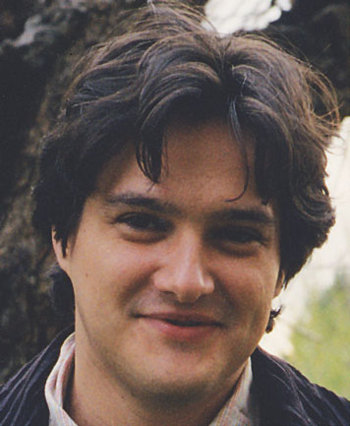 When I asked author and “silly chick” Andrea Beaty what she thought about the work of Belgian illustrator Pascal Lemaitre, who has illustrated three of her titles thus far, and she said that he “is so funny and original and his art is brilliant,” I found myself nodding along. “The thing that constantly amazes me,” Andrea added, “is how simple his illustrations seem, but they have so much going on. Even after reading one of our books over and over, I find new details that crack me up!”
When I asked author and “silly chick” Andrea Beaty what she thought about the work of Belgian illustrator Pascal Lemaitre, who has illustrated three of her titles thus far, and she said that he “is so funny and original and his art is brilliant,” I found myself nodding along. “The thing that constantly amazes me,” Andrea added, “is how simple his illustrations seem, but they have so much going on. Even after reading one of our books over and over, I find new details that crack me up!”
I love Pascal’s work. There is an understatement to it that charms and a seeming simplicity. But, as Andrea said, there’s much to take in. Best of all, as you can see from some of the illustrations on display in this interview, Lemaitre knows how to embrace the softer elements of childhood, yet isn’t afraid to embrace his Inner Grimm — and if you’re a regular reader of this blog, you know that I’m a fan of those authors and illustrators who do so, seeing as how it really is good for children to face these kinds of fears. See what I mean? This is from Ogre noir by Édith et Rascal, published in France in 2006. Yikes:

Pascal has illustrated books for several French publishers. You’ll see a selection of images from some of those titles in this interview. And he does editorial work regularly for publications such as The New Yorker, The New York Times Book Review, and Time (as well as many publications in France and Belgium, including editorial illustrations for children’s publications). Here in the U.S., he has brought us titles such as Andrea’s 2008 picture book, Doctor Ted (Margaret K. McElderry Books). Pascal knows how to bring us the Grimm-esque, but he also knows how to bring us The Funny — how to bring, rather, Andrea’s laugh-outloud tale of imaginative play and its self-confident protagonist to life. Seriously, have you read Doctor Ted? (I’m hoping Andrea can stop by soon to chat about her work, too.)
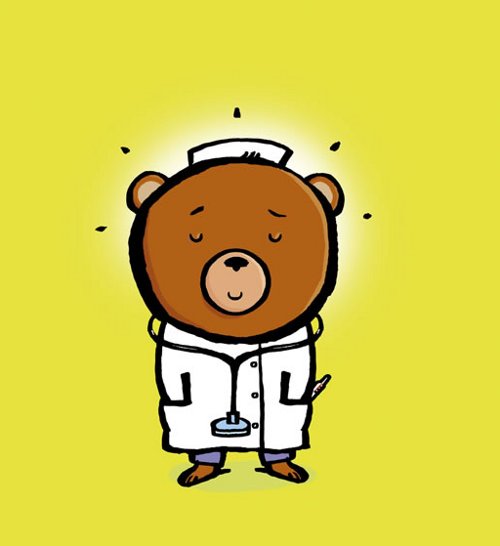
And, as you’ll read below, we’ll all get treated in September to the sequel, Firefighter Ted. Pascal has also recently illustrated Alison McGhee’s Always, a book about the lengths a dog will go to protect its owner and friend. (Both titles are from Simon & Schuster.)
He’s here this morning for a cyber-breakfast that I wish weren’t merely cyber, since it’d be wonderful to meet him in person and since his breakfast of choice is “slices of buttered bread dipped in a soft-boiled egg.” Yum. Pascal asked me to excuse his English, since he’s French-speaking, but I think his English is just fine, and I thank him for taking the time to do the interview. Let’s get right to it.
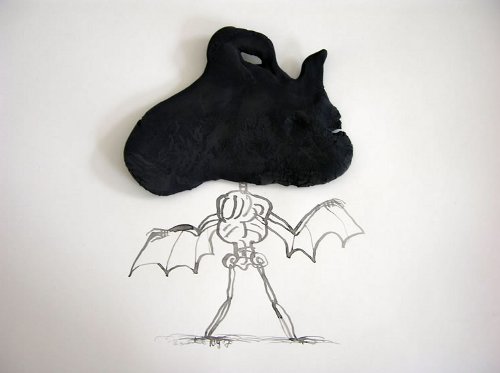
7-Imp: Are you an illustrator or author/illustrator?
Pascal: Illustrator.
7-Imp: What illustrated titles do you have out now?

Pascal: Always is out. Two books written by Andrea Beaty (Doctor Ted and Firefighter Ted, both published by Margaret K.McElderry books, and Hush, Baby Ghostling).
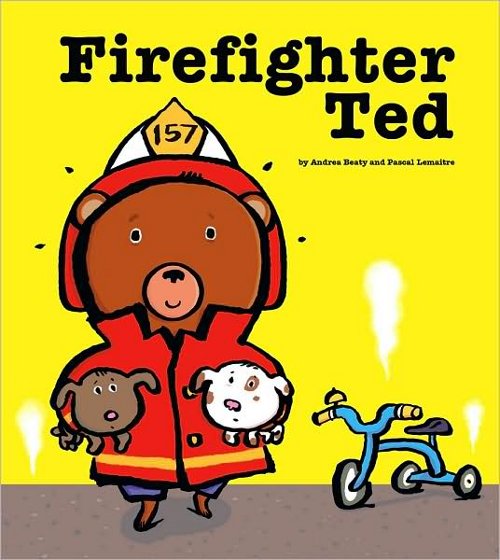
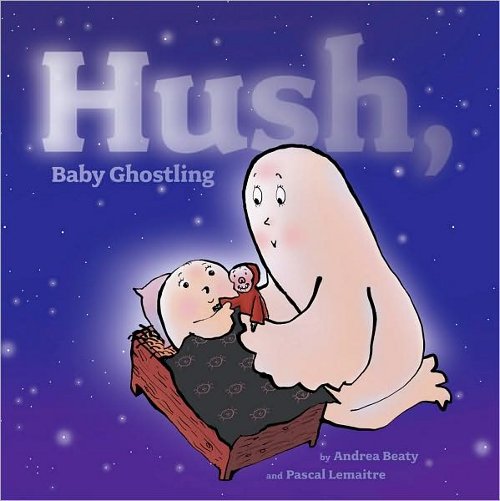
7-Imp: What is your usual medium, or -– if you use a variety -– your preferred one?
Pascal: For The Book of Mean People by Toni Morrison: pen and ink plus watercolor. For Always by Alison McGhee: drawing with pencil and color on Photoshop. I mainly work with pen and ink plus color on Photoshop, which widens my color range, which is limited in watercolor as I’m not an expert in that medium.

by Toni and Slade Morrison (Hyperion, 2002)
7-Imp: If you have illustrated for various age ranges (such as both picture books and early reader books OR, say, picture books and chapter books), can you briefly discuss the differences, if any, in illustrating for one age group from another?
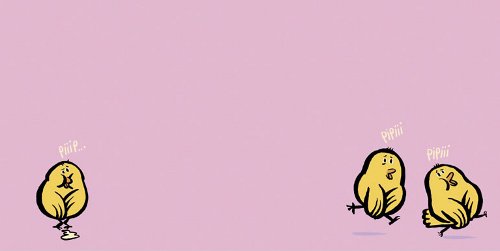
by Maëlle and Pascal Lemaitre (Casterman, 2008)
Pascal: The thought will be simply around the use of an image in the book. Is it twelve spreads linked to each other, where I would need to create a specific rhythm? Would I go for spreads and spot illustrations? It’s always a question of what suits best with the text.
For example, in chapter books I try to avoiding repeating visually what is written. I feel a text can be stronger, as it leaves the reader to use his own imagination. Sometimes, I ask my students to illustrate a poem by Baudelaire. Somehow, it’s a heresy, as the poem is so powerful you don’t need to illustrate it. But what is interesting is to create your own world around a writer. And in school I feel it’s better to work on strong authors. So, in short, I would say every author I’ve worked with was my Baudelaire, with whom I had to find my place and serve the text, while finding a solution in the rhythm of that object where you turn pages: the book.
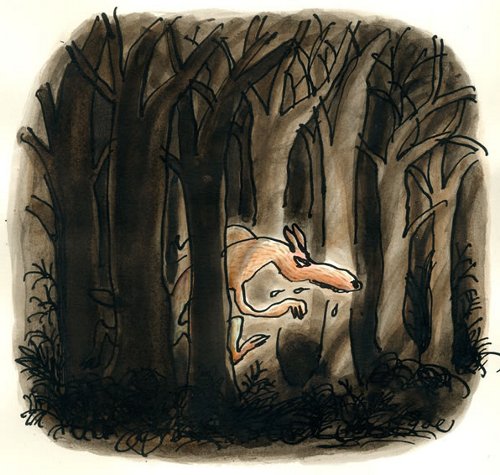
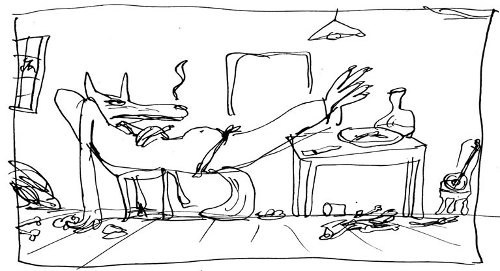
7-Imp: Where are your stompin’ grounds?
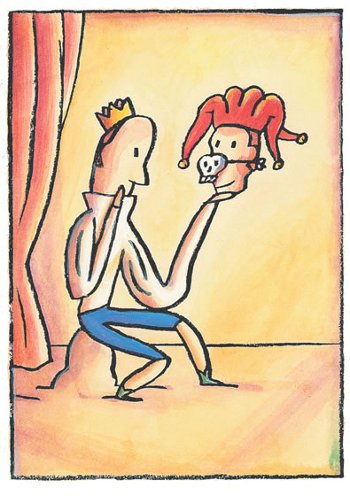 Pascal {pictured here is one of Pascal’s pieces for The New York Times}: I used to follow my wife while she was touring with M. Baryshnikov in different countries. (I went on working via the Internet and a portable scanner). Now we have to be near our daughter’s school in Belgium. But we still spend summer-time and other vacations in Brooklyn.
Pascal {pictured here is one of Pascal’s pieces for The New York Times}: I used to follow my wife while she was touring with M. Baryshnikov in different countries. (I went on working via the Internet and a portable scanner). Now we have to be near our daughter’s school in Belgium. But we still spend summer-time and other vacations in Brooklyn.
We are also part-time in Normandy, France, where we have good old friends. My wife is actually choreographing with Khmer dancers, so we travel also to Thailand and Cambodia, when possible. Everywhere I find a little spot to put my scanner and MacBook to go on working. Sometimes it feels uncomfortable not to be in my den, but I would find it depressing to be stuck on the same chair at the same table for months and months and months. I also do a job where I could be very alone, and traveling with family and working with them around helps me avoid total solitude (even if I need that solitude from time to time to dive into my own inner swamps, on top of which might bloom a lotus.)
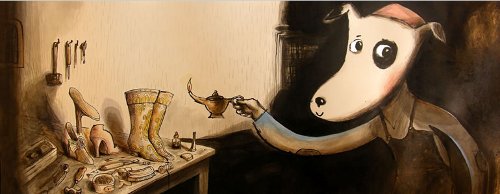
7-Imp: Can you briefly tell us about your road to publication?
Pascal: First, I did a lot of drawings for French and Belgian magazines, then book editors, and ten years ago I was hired by Pippin Properties, which built my American career.
I had sent a dummy for a book to Michaela Muntean, who sent it to Holly McGhee. Since then, I’ve had a very constructive and affectionate relationship with Holly and Emily Van Beek, who works in international rights. One of my first collaborations was with Toni Morrison. I was awfully lucky; she is a sun.

by Toni and Slade Morrison (Scribner, 2003)
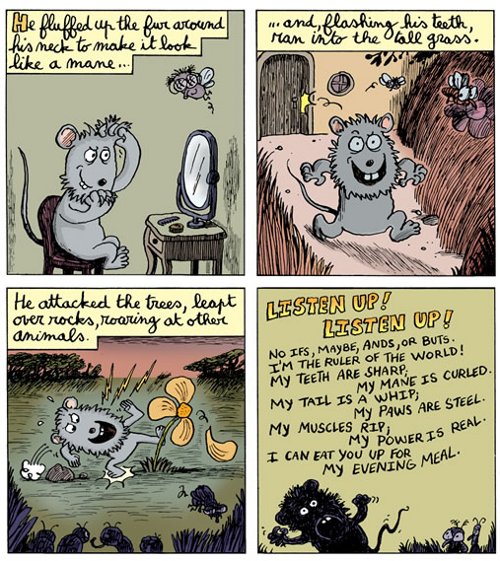
by Toni and Slade Morrison (Scribner, 2003)
7-Imp: Can you please point us to your web site and/or blog?
Pascal: www.pascallemaitre.com.
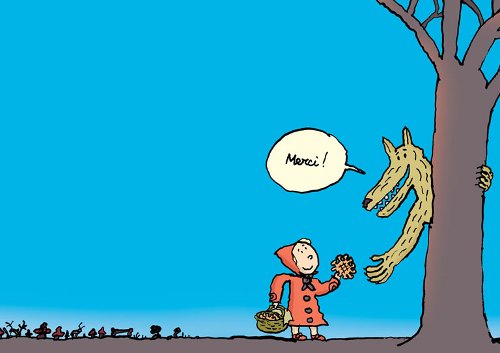
7-Imp: If you do school visits, tell us what they’re like.
Pascal: I explain how I do a book: the architecture of the book with rhythm, and why. Then, I ask kids to create a hero or a monster that expresses their inner fears. It usually ends with me drawing the kids’ favorite pets.
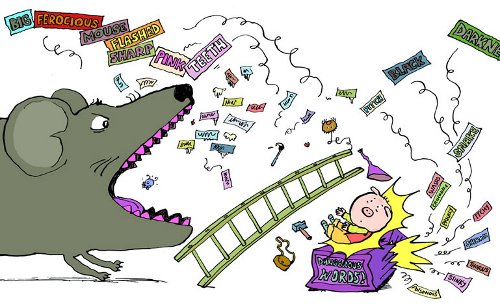
7-Imp: If you teach illustration, by chance, tell us how that influences your work as an illustrator.
Pascal: It forces me to analyze the process of working on a book with writers and agents and art directors and editors and printers, etc….and to find words to guide students. So, sometimes it can help me clarify what doesn’t work in a problem I try solving for myself. Also in the every day life, I focus on stuff I can speak about to the students. For exemple, if I read a book, I’ll take notes to use them during classes. It gives a different approach than reading only for my…self.
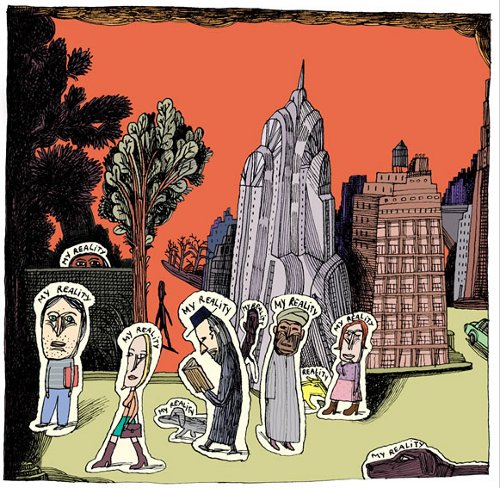
7-Imp: Any new titles/projects you might be working on now that you can tell us about?
Pascal: I’m working on A Bulldog Day by Kate McMullan for Scholastic. It’s a big book with a lot of funny actions and details. Kate’s text is a little chef d’oeuvre. Ken Geist is the very smart editor and Marijka Kostiw, a great designer.
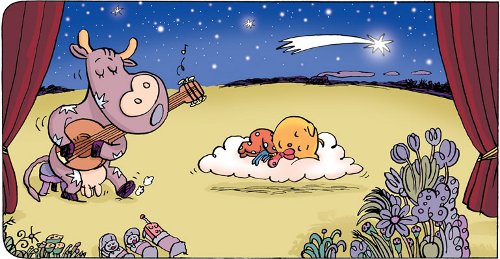

(Hyperion, 2004)
 Our table’s set, and breakfast is ready. Time for the Big Seven. Let’s keep at it…
Our table’s set, and breakfast is ready. Time for the Big Seven. Let’s keep at it…
1. 7-Imp: What exactly is your process when you are illustrating a book? You can start wherever you’d like when answering: getting initial ideas, starting to illustrate, or even what it’s like under deadline, etc. Do you outline a great deal of the book before you illustrate or just let your muse lead you on and see where you end up?
Pascal: I read the text, then let it brew for a few hours or days; it depends. And, usually, you have to create the main character who will carry the story. It’s like preparing a theater piece, but you have to draw the casting of actors you would pick, then create the props, think about the lighting, etc. The type is like the voices of the actors-narrators; you have to be careful with the design too. It’s all very exciting.
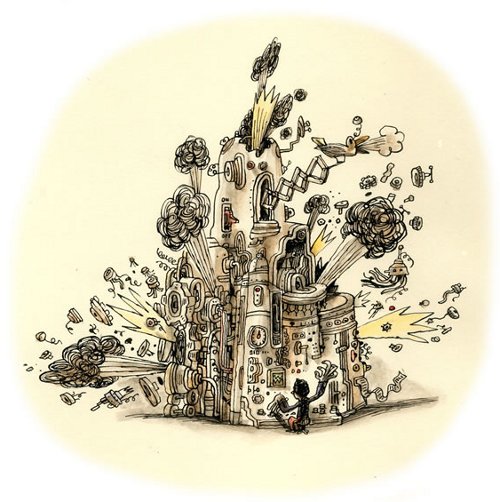
In the case of Always, I wanted to find an endearing little fellow and, of course, play the contrast between his task and his size — and also between his tiny size and the double spread of the book. The setting of the wide space of the pages was important in serving the meaning of the poem on courage from a tiny one in a huge castle. I feel kids can relate to that situation, as we do as adults while watching the sky.
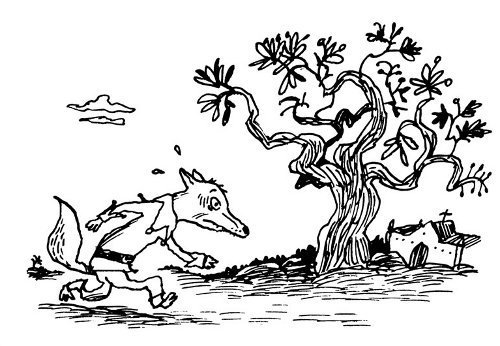
 {Ed. Note: Image here is from Pascal’s sketchbook.}
{Ed. Note: Image here is from Pascal’s sketchbook.}
I wanted to surprise Alison McGhee in the way I interpreted her text, feeling that surprising ideas would also satisfy the reader. There are a lot of illustrators far more talented than myself, so I feel my approach is to try finding new ideas.
About the atmosphere created by the colors, it’s in the same range as for The Book of Mean People. I have to say Japanese prints are a good source of inspiration. The little fellow needed a little belly, as young puppies do, to help mark the age of a young character on an important mission. Charlie Chaplin is the perfect example to use for creating a strong and touching character with simplicity. In Always, the little girl appears only at the beginning and the end of the book, just to emphasize at the end the meaning of devotion. A big part of the job is to think about the visual structure for carrying the poem.
The work of the art director and editor is also crucial, as they help to work through the storm of creation and add a lot of elements. In this case, Ann Bobco gave texture to the voice of the narrator through the right choice of type and an appealing cover. The trust and support of the editor, Paula Wiseman, was also crucial, as it gave confidence during the creative process. And I don’t want to forget the advice of my agent, Holly McGhee, who knows me enough to guide me in the right direction, in spite of my many doubts.
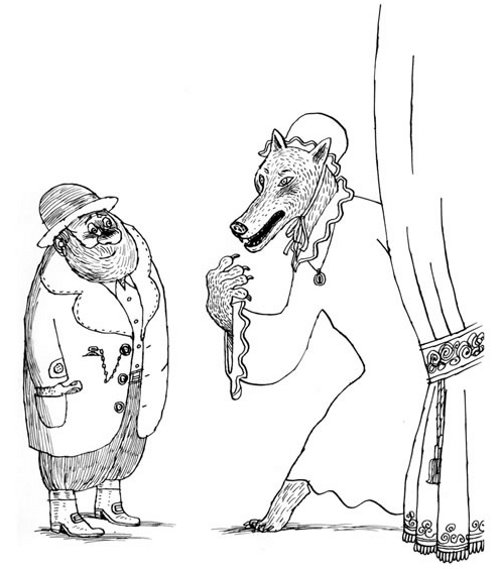
2. 7-Imp: Describe your studio or usual work space for us.
Pascal: As described previously, I would say it’s the family space when we travel. Even when we are at home in Brussels, I tend to draw on the table of the kitchen. (I go to my own studio downstairs when needed.) Looking for ideas in a public place with a sketchbook is also a common practice I use, as do other illustrators.
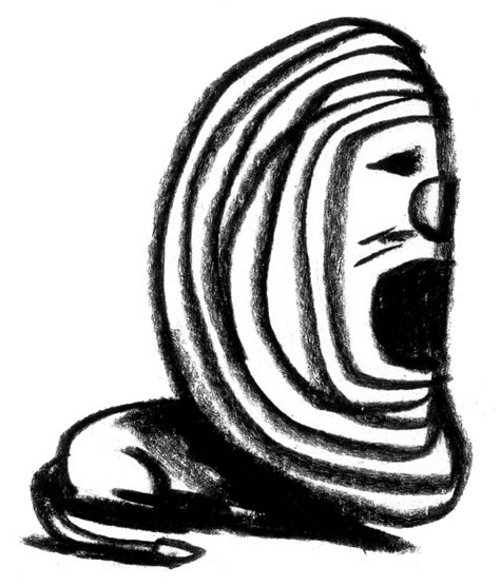
3. 7-Imp: As book lovers, it interests us: What books or authors and/or illustrators influenced you as an early reader?
Pascal: I was not a big reader as a kid. I was an image-and-drawings eater. I was crazy about a Belgian comic strip artist named André Franquin; then I was touched by the engravings of Rembrandt; and later, discovered André François’ work was a way to solve graphic problems with drawings without being too serious. It is a bridge between fun and Rembrandt, if I dare to say so.
Another big influence was Bill Steig, whom I was lucky to meet in Boston with his marvelous wife Jeanne, artist and poet. I even sat in his orgone box, gathering energy.

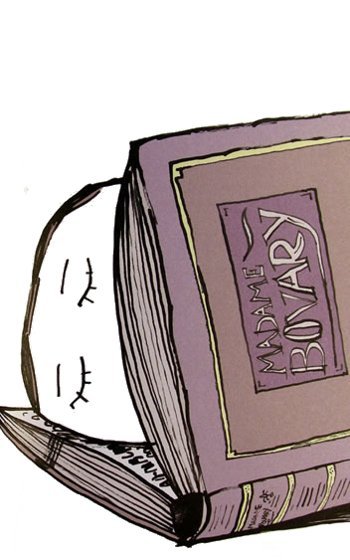 4. 7-Imp {Note: The illustration here is from Flaubert’s Le dictionnaire des idées reçues with illustrations from Serge Bloch and Lemaitre, 2006}: If you could have three (living) illustrators—whom you have not yet met—over for coffee or a glass of rich, red wine, whom would you choose?
4. 7-Imp {Note: The illustration here is from Flaubert’s Le dictionnaire des idées reçues with illustrations from Serge Bloch and Lemaitre, 2006}: If you could have three (living) illustrators—whom you have not yet met—over for coffee or a glass of rich, red wine, whom would you choose?
Pascal: You can connect to authors and illustrators through their work. So, I leave chance to decide. They are not the most interesting people in the world; a man like Bill is very rare. I’m more touched by dancers, for example. There is often a genuine and sincere dedication to the Arts in them. Most of them have no money and dance for the sake of dancing.
There is perhaps one man in the visual world with whom I’d love to share some silence around a cup of coffee, the photographer Robert Frank. And in the other world I’ll go and ring the bell of James Ensor and Rembrandt.
The problem is my mother-in-law was a humanitarian activist to whom John le Carré dedicated The Constant Gardener. And when you spend time with people of such quality and generosity of soul, it’s difficult to be satisfied with the average people (among whom I’m included).
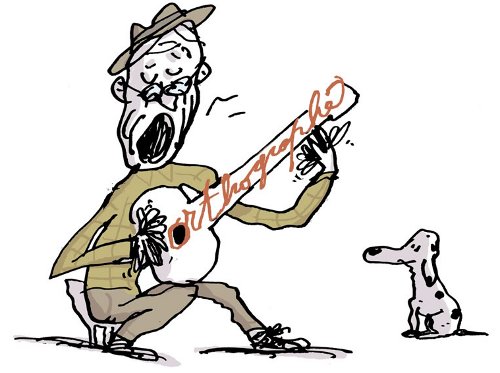
5. 7-Imp: What is currently in rotation on your iPod or loaded in your CD player? Do you listen to music while you create books?
Pascal: It depends. It goes from Edith Piaf, Jacques Brel, and Alain Bashung to Johnny Cash, while stopping by Joy Division and Glenn Gould.
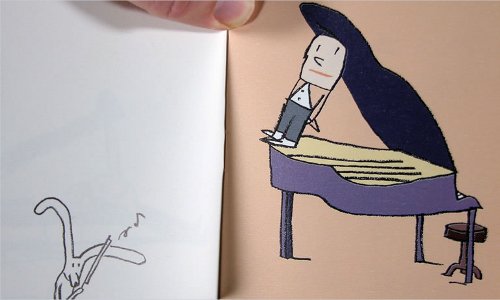
6. 7-Imp: What’s one thing that most people don’t know about you?
Pascal: If they don’t know it’s that they don’t have to know. I feel I have to protect myself, due to growing up in a manly world as a sensitive guy. This is typical for lots of guys.
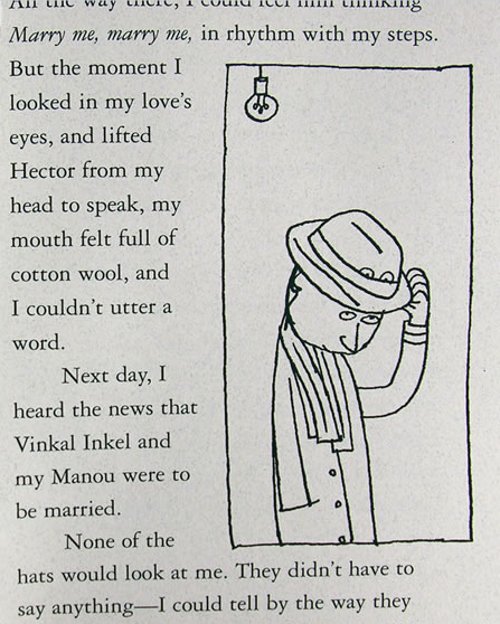
7. 7-Imp: Is there something you wish interviewers would ask you, but never do? Feel free to ask and respond here.
Pascal: When you talk and exchange words with students, you can build something, but in interviews about my work, I feel it is not interesting. Our job has been described so many times by other illustrators in better words. It’s always the same things said. And I don’t like egotistical artistic manners. It’s so ridiculous in a world so wide and wild where we need to stand united.
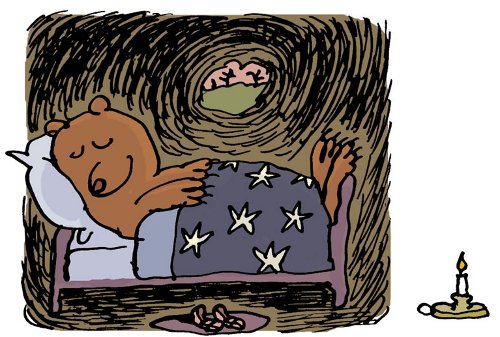
7-Imp: What is your favorite word?
Pascal: My daughter’s name, of course: Maëlle.
7-Imp: What is your least favorite word?
Pascal: To give up.
7-Imp: What turns you on creatively, spiritually or emotionally?
Pascal: Lines of drawings, containing vital signs. Poems containing vital signs.
7-Imp: What turns you off?
Pascal: Dead words and deadlines. People born retired.
7-Imp: What is your favorite curse word? (optional)
Pascal: “Merdre” (in Père Ubu by Jarry).
7-Imp: What sound or noise do you love?
Pascal: Birds in the early spring morning.
7-Imp: What sound or noise do you hate?
Pascal: Construction work in the early spring morning.
7-Imp: What profession other than your own would you like to attempt?
Pascal: Psychiatrist.
7-Imp: What profession would you not like to do?
Pascal: Worker in a coal mine.
7-Imp: If Heaven exists, what would you like to hear God say when you arrive at the Pearly Gates?
Pascal: “Your wife and daughter are safe and will have a happy and rich life. And here, for you, is the light and your tools.”
Note: For some really fabulous photographs at Pascal’s site of William Steig, Toni Morrison, Slade Morrison, and Baryshnikov (all mentioned above), go here, visit the “Scrapbook” page, and click on “Photographies.” (Baryshnikov’s photos are under “USA, Austria, Italy, dance.”) That is, in particular, one wonderful photo of Steig, I have to say.
All artwork taken from the website of Pascal Lemaitre with permission from the illustrator. All rights reserved.
Photo of Pascal courtesy of Simon & Schuster.
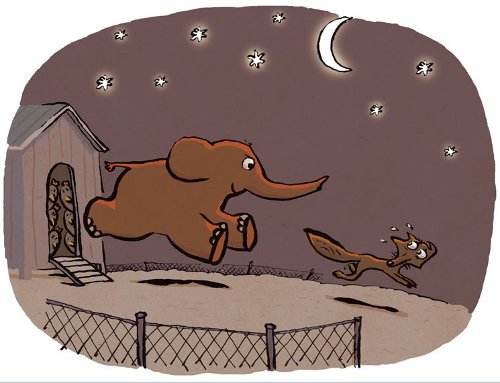

I hope I don’t embarrass Pascal by saying that he is clearly a lovely, lovely soul. There are so many wonderful quotes that I had to stop writing them down and just print out the entire post, but my favorites were his need for solitude “from time to time to dive into my own inner swamps, on top of which might bloom a lotus” (pure poetry) and being turned off by “people born retired” (I know a few of these).
Pascal’s art is whimsical and quirky and utterly charming, and he has a new fan in me – thank you for the interview, Jules. This blog just keeps getting better and better!
Like Jill, I loved the lotus-from-inner-swamps phrase.
And you know what was odd? (“Odd” isn’t the right word, exactly, but it will do for now.) I found this entire interview — illustrations complemented by the text — very moving. Many of the illustrators you feature here strike me as great people to have a beer or coffee or complete meal with; in Pascal’s case, although he’s clearly an exceptional friend, I think I would feel 100% shy in his presence.
So glad he got to know Steig. I’ll bet WS was tickled by Pascal’s work, and remains so (from a greater distance).
My favorite illustration here is the one of the person — child? — whose slumbrous head is propping open Madame Bovary, to illustrate one of the “received ideas” in Flaubert’s own encyclopedia/dictionary. Ha!
Thanks, you all. My favorite=him describing Toni Morrison as “a sun.” Wouldn’t you love someone to describe you as a sun?
And, you know, his art. I’ve always liked it. The photographs at his site are gorgeous, too.
I also love how he refers at one point to the text of the picture book he’s illustrating as a “poem.”
brilliant. i’m sure i’ve seen his work before but this is a great interview and a collection of work. thanks for this, i now have a new illustrator to follow.
Oh, how I love this interview! Clearly a beautiful and sensitive soul. “Sharing some silence around a cup of coffee,” and describing TM as a “sun” = *swoon*.
Are those little hot dogs in the Old Woman illo? Pascal’s style is refreshing, quirky, and whimsical. Love the spreads you’ve shared here. Thanks!
Jama, if I’m remembering correctly, they’re sausages. I love that book, and I remember reading it repeatedly to the girls when they were younger. I believe some sausages get loose and inhabit every spread, but don’t quote me on that, since I don’t actually own the book and can’t go reference it. I’m 99% sure, though.
Thanks!
Simply wonderful!!!!! What else can I say?
Hi Pascal! Kudos on your artwork, and kudos to your wife on her dance career! Hello to your daughter. I think it’s lovely that her name is your favorite word. Your answer to the last question . . . wow.
You know what I enjoy most about the art seen here? How varied it is. Grandma, what big range you have! Each piece has its own look and feel, and I think that’s very neat.
I recognized your name from Always, which is on my to-read list since I enjoy Alison McGhee’s works.
From comic books to Rembrandt, from John LeCarre to William Steig, and from Edith Piaf to Johnny Cash. I love this young man’s eclecticism! (And someday, wouldn’t it be nice to have someone call your text a “chef d’oeuvre” – ? Sweet.)
Pascal certainly has inner whimsy exuding from his inner Steig too ~ what a fascinating multi-faceted character ~ thanks for sharing this gem of an illustrator!
[…] still find stuff to talk about the entire time? That’s Rachel. I’m gonna steal Pascal Lemaitre’s wording and say that Rachel is a sun. (Shannon, too, but you know…I’m singling Rachel […]
[…] of thinking), and who is illustrated by Pascal Lemaitre, who stopped by and had breakfast with me last month, you may remember. You also may remember that, during April of ‘08, our imaginative […]
[…] 2008’s Doctor Ted, followed by last year’s Firefighter Ted, both illustrated by Pascal Lemaitre; and last year’s Hush, Baby Ghostling, also illustrated by […]
[…] as illustrator Pascal Lemaitre said about author Toni Morrison in my 2009 interview with him, Cristiana is a sun. (I love that. I have lifted that phrase to describe personalities like […]